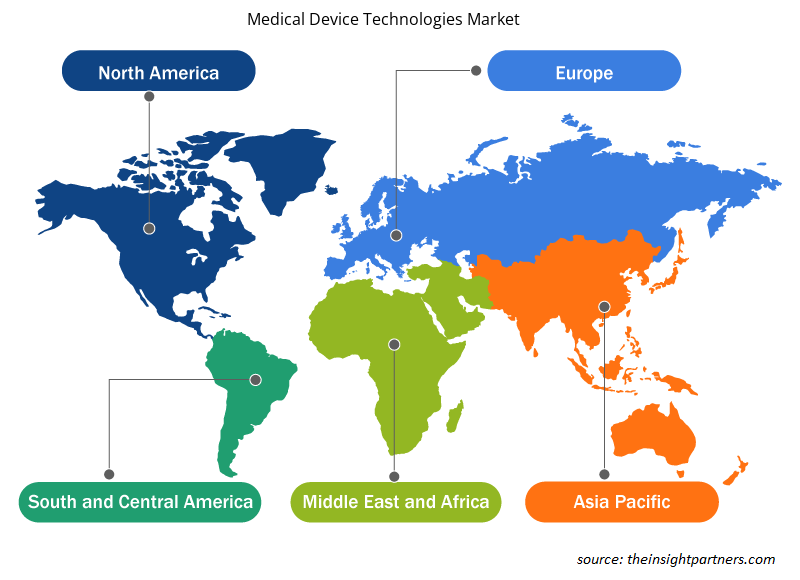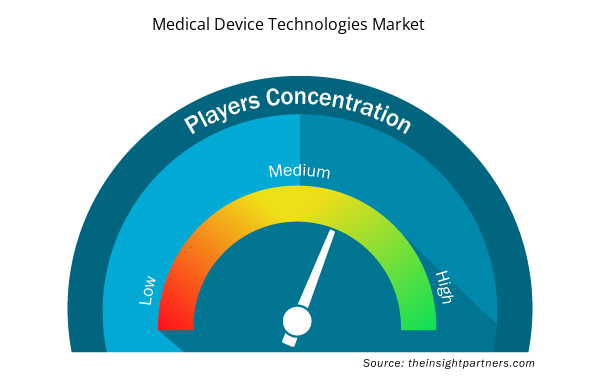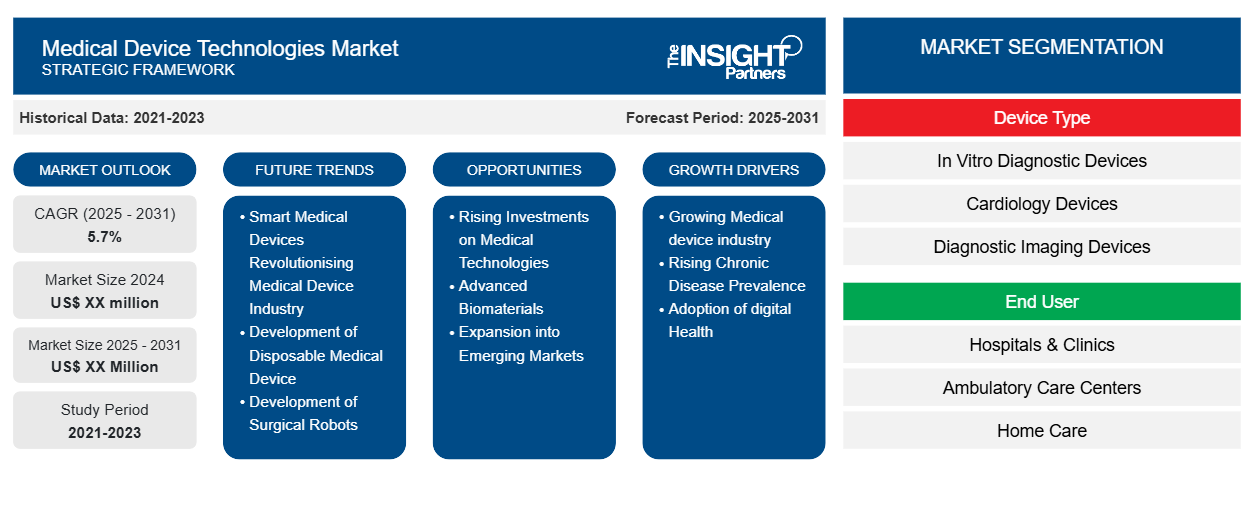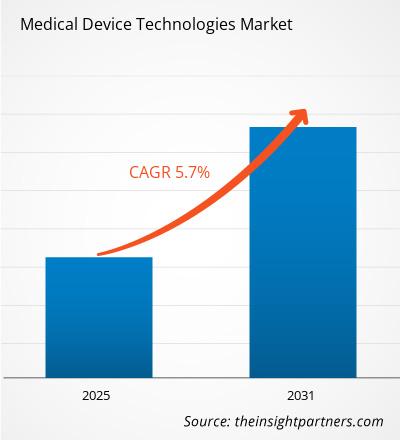Se espera que el mercado de tecnologías de dispositivos médicos registre una CAGR del 5,7 % entre 2024 y 2031, con un tamaño de mercado que se expandirá de US$ XX millones en 2024 a US$ XX millones en 2031.
El informe está segmentado por tipo de dispositivo (dispositivos de diagnóstico in vitro (IVD), dispositivos de cardiología, dispositivos de diagnóstico por imágenes, dispositivos ortopédicos, dispositivos de oftalmología, dispositivos de endoscopia, dispositivos para el cuidado de la diabetes, dispositivos para el tratamiento de heridas, dispositivos renales/de diálisis, dispositivos de anestesia y atención respiratoria y otros). El informe presenta además un análisis basado en el usuario final (hospitales y clínicas, centros de atención ambulatoria, atención domiciliaria y otros). El análisis global se desglosa aún más a nivel regional y por países principales. El informe ofrece el valor en USD para el análisis y los segmentos anteriores.
Propósito del Informe
El informe Medical Device Technologies Market de The Insight Partners tiene como objetivo describir el panorama actual y el crecimiento futuro, los principales factores impulsores, los desafíos y las oportunidades. Esto proporcionará información a diversas partes interesadas del negocio, como:
- Proveedores/fabricantes de tecnología: Para comprender la dinámica cambiante del mercado y conocer las oportunidades potenciales de crecimiento, lo que les permitirá tomar decisiones estratégicas informadas.
- Inversionistas: Realizar un análisis exhaustivo de tendencias sobre la tasa de crecimiento del mercado, las proyecciones financieras del mercado y las oportunidades que existen en toda la cadena de valor.
- Órganos reguladores: Regular las políticas y vigilar las actividades del mercado con el objetivo de minimizar los abusos, preservar la confianza de los inversores y defender la integridad y la estabilidad del mercado.
Segmentación del mercado de tecnologías de dispositivos médicos
Tipo de dispositivo
- Dispositivos de diagnóstico in vitro
- Dispositivos de cardiología
- Dispositivos de diagnóstico por imágenes
- Dispositivos ortopédicos
- Dispositivos de oftalmología
- Dispositivos de endoscopia
- Dispositivos para el cuidado de la diabetes
- Dispositivos para el tratamiento de heridas
- Dispositivos para diálisis y riñones
- Dispositivos de anestesia y cuidados respiratorios
- Otros
Usuario final
- Hospitales y clínicas
- Centros de atención ambulatoria
- Cuidados en el hogar
- Otros
Personalice este informe según sus necesidades
Obtendrá personalización en cualquier informe, sin cargo, incluidas partes de este informe o análisis a nivel de país, paquete de datos de Excel, así como también grandes ofertas y descuentos para empresas emergentes y universidades.
- Obtenga las principales tendencias clave del mercado de este informe.Esta muestra GRATUITA incluirá análisis de datos, desde tendencias del mercado hasta estimaciones y pronósticos.
Factores impulsores del crecimiento del mercado de tecnologías de dispositivos médicos
- Creciente industria de dispositivos médicos: los dispositivos médicos son esenciales para la prevención, el diagnóstico, el tratamiento y la rehabilitación de cualquier afección médica. Según AdvaMed, Estados Unidos es el mercado de dispositivos médicos más grande del mundo y comprende más del 40 % del mercado mundial de tecnología médica.
- Aumento de la prevalencia de enfermedades crónicas:
la creciente prevalencia de enfermedades crónicas, como enfermedades neurológicas, enfermedades cardiovasculares (ECV), cáncer, diabetes, accidentes cerebrovasculares y enfermedades renales, aumenta la demanda de dispositivos médicos para fines de diagnóstico y tratamiento. Según los CDC, en los EE. UU., el noventa por ciento de los gastos anuales en atención médica (4,5 billones de dólares estadounidenses) se destinan a personas con enfermedades crónicas y de salud mental. - Adopción de la salud digital: las mejoras en la salud digital son el factor clave que impulsa el mercado de las tecnologías de dispositivos médicos. La creciente adopción de la salud digital en la telemedicina y el monitoreo remoto de pacientes, y los avances en IA, ML e IoT están impulsando el desarrollo de dispositivos más sofisticados que podrían recopilar y analizar datos de pacientes en tiempo real, mejorando así los resultados de la atención médica y reduciendo los costos.
Tendencias futuras del mercado de tecnologías de dispositivos médicos
- Los dispositivos médicos inteligentes están revolucionando la industria de los dispositivos médicos: el Internet de las cosas (IdC) está revolucionando la industria de la salud y la medicina y generando enormes avances. Las sólidas actividades de I+D en el sector sanitario han dado lugar a innovaciones en los dispositivos médicos. Las empresas de dispositivos médicos están incorporando inteligencia artificial (IA) e IdC para mejorar los resultados clínicos.
- Desarrollo de un dispositivo médico desechable: Desarrollo de un dispositivo médico desechable para reducir las posibilidades de infección durante los procedimientos de tratamiento. En 2024, Inspira Technologies OXY BHN Ltd., pionera en tecnología de soporte vital, anunció su plan de lanzar un kit de oxigenación sanguínea desechable de un solo uso.
- Desarrollo de robots quirúrgicos: los robots quirúrgicos realizan procedimientos mínimamente invasivos y ofrecen control, precisión y flexibilidad durante los procedimientos quirúrgicos. En junio de 2024, Meril, una empresa de dispositivos médicos con sede en la India, anunció el lanzamiento de su tecnología robótica quirúrgica avanzada desarrollada, MISSO, que brindará asistencia a los cirujanos durante los procedimientos de reemplazo de rodilla en tiempo real.
Oportunidades de mercado en tecnologías de dispositivos médicos
- Aumento de las inversiones en tecnologías médicas: las inversiones en actividades de investigación y desarrollo médico están aumentando en todo el mundo. Según el informe de Germany Trade & Investreport, el gasto en tecnología médica y diagnóstico in vitro (IVD) en Alemania alcanzó los 43 000 millones de euros en 2022.
- Biomateriales avanzados: Existe un amplio campo de negocio en el desarrollo de biomateriales avanzados que se aplicarán a los dispositivos médicos. Los nuevos biomateriales, como los nanomateriales, los polímeros y las cerámicas, se están utilizando ampliamente en el sector de los dispositivos médicos, debido a la creciente necesidad de dispositivos biocompatibles, más resistentes y eficientes.
- Expansión en mercados emergentes: Se espera que la industria de dispositivos médicos se expanda rápidamente en los mercados emergentes de Asia-Pacífico y América Latina debido a la alta demanda de dispositivos médicos. Según Invest India, India es el cuarto mercado más grande de dispositivos médicos en Asia. Se espera que la mejora del escenario de reembolso y el aumento de la inversión del gobierno en el aumento de la industria de tecnología médica ofrezcan oportunidades
Perspectivas regionales del mercado de tecnologías de dispositivos médicos
Los analistas de Insight Partners explicaron en detalle las tendencias y los factores regionales que influyen en el mercado de tecnologías de dispositivos médicos durante el período de pronóstico. Esta sección también analiza los segmentos y la geografía del mercado de tecnologías de dispositivos médicos en América del Norte, Europa, Asia Pacífico, Oriente Medio y África, y América del Sur y Central.

- Obtenga datos regionales específicos para el mercado de tecnologías de dispositivos médicos
Alcance del informe de mercado de tecnologías de dispositivos médicos
| Atributo del informe | Detalles |
|---|---|
| Tamaño del mercado en 2024 | XX millones de dólares estadounidenses |
| Tamaño del mercado en 2031 | US$ XX millones |
| Tasa de crecimiento anual compuesta (CAGR) global (2025-2031) | 5,7% |
| Datos históricos | 2021-2023 |
| Período de pronóstico | 2025-2031 |
| Segmentos cubiertos | Por tipo de dispositivo
|
| Regiones y países cubiertos | América del norte
|
| Líderes del mercado y perfiles de empresas clave |
|
Densidad de actores del mercado de tecnologías de dispositivos médicos: comprensión de su impacto en la dinámica empresarial
El mercado de tecnologías de dispositivos médicos está creciendo rápidamente, impulsado por la creciente demanda de los usuarios finales debido a factores como la evolución de las preferencias de los consumidores, los avances tecnológicos y una mayor conciencia de los beneficios del producto. A medida que aumenta la demanda, las empresas amplían sus ofertas, innovan para satisfacer las necesidades de los consumidores y aprovechan las tendencias emergentes, lo que impulsa aún más el crecimiento del mercado.
La densidad de actores del mercado se refiere a la distribución de las empresas o firmas que operan dentro de un mercado o industria en particular. Indica cuántos competidores (actores del mercado) están presentes en un espacio de mercado determinado en relación con su tamaño o valor total de mercado.
Las principales empresas que operan en el mercado de tecnologías de dispositivos médicos son:
- SERVICIOS JOHNSON & JOHNSON, INC.
- ELECTRICIDAD GENERAL
- Smith y sobrino
- Estiramiento
- MEDTRÓNICA
Descargo de responsabilidad : Las empresas enumeradas anteriormente no están clasificadas en ningún orden particular.

- Obtenga una descripción general de los principales actores clave del mercado de tecnologías de dispositivos médicos
Puntos de venta clave
- Cobertura integral: el informe cubre de manera integral el análisis de productos, servicios, tipos y usuarios finales del mercado de tecnologías de dispositivos médicos, proporcionando un panorama holístico.
- Análisis de expertos: el informe se compila sobre la base de un profundo conocimiento de expertos y analistas de la industria.
- Información actualizada: El informe asegura relevancia comercial debido a su cobertura de información reciente y tendencias de datos.
- Opciones de personalización: este informe se puede personalizar para satisfacer los requisitos específicos del cliente y adaptarse adecuadamente a las estrategias comerciales.
Por lo tanto, el informe de investigación sobre el mercado de tecnologías de dispositivos médicos puede ayudar a abrir el camino para descifrar y comprender el escenario de la industria y las perspectivas de crecimiento. Si bien puede haber algunas preocupaciones válidas, los beneficios generales de este informe tienden a superar las desventajas.
- Análisis histórico (2 años), año base, pronóstico (7 años) con CAGR
- Análisis PEST y FODA
- Tamaño del mercado Valor/volumen: global, regional, nacional
- Industria y panorama competitivo
- Conjunto de datos de Excel



Report Coverage
Revenue forecast, Company Analysis, Industry landscape, Growth factors, and Trends

Segment Covered
This text is related
to segments covered.

Regional Scope
North America, Europe, Asia Pacific, Middle East & Africa, South & Central America

Country Scope
This text is related
to country scope.
Preguntas frecuentes
The medical device technologies market is estimated to grow with a CAGR of 5.7% from 2023 to 2031.
Asia Pacific region is likely to witness the fastest growth rate during the forecast period.
The market drivers include the increasing prevalence of chronic disorders and growing global medical device industry, which are driving the medical device technologies market.
The medical device technologies market majorly consists of players such as Stryker, Medtronic, Zimmer Biomet Holding Inc., among others.
Development of surgical robots are likely to remain the key trend during the forecast period.
North America dominated the medical device technologies market in 2023
Trends and growth analysis reports related to Life Sciences : READ MORE..
1. JOHNSON & JOHNSON SERVICES, INC.
2. GENERAL ELECTRIC
3. SMITH & NEPHEW
4. STRYKER
5. MEDTRONIC
6. SIEMENS HEALTHCARE PRIVATE LIMITED
7. KONINKLIJKE PHILIPS N.V.
8. F. HOFFMANN-LA ROCHE LTD
9. ABBOTT.
10. BOSTON SCIENTIFIC CORPORATION
The Insight Partners performs research in 4 major stages: Data Collection & Secondary Research, Primary Research, Data Analysis and Data Triangulation & Final Review.
- Data Collection and Secondary Research:
As a market research and consulting firm operating from a decade, we have published and advised several client across the globe. First step for any study will start with an assessment of currently available data and insights from existing reports. Further, historical and current market information is collected from Investor Presentations, Annual Reports, SEC Filings, etc., and other information related to company’s performance and market positioning are gathered from Paid Databases (Factiva, Hoovers, and Reuters) and various other publications available in public domain.
Several associations trade associates, technical forums, institutes, societies and organization are accessed to gain technical as well as market related insights through their publications such as research papers, blogs and press releases related to the studies are referred to get cues about the market. Further, white papers, journals, magazines, and other news articles published in last 3 years are scrutinized and analyzed to understand the current market trends.
- Primary Research:
The primarily interview analysis comprise of data obtained from industry participants interview and answers to survey questions gathered by in-house primary team.
For primary research, interviews are conducted with industry experts/CEOs/Marketing Managers/VPs/Subject Matter Experts from both demand and supply side to get a 360-degree view of the market. The primary team conducts several interviews based on the complexity of the markets to understand the various market trends and dynamics which makes research more credible and precise.
A typical research interview fulfils the following functions:
- Provides first-hand information on the market size, market trends, growth trends, competitive landscape, and outlook
- Validates and strengthens in-house secondary research findings
- Develops the analysis team’s expertise and market understanding
Primary research involves email interactions and telephone interviews for each market, category, segment, and sub-segment across geographies. The participants who typically take part in such a process include, but are not limited to:
- Industry participants: VPs, business development managers, market intelligence managers and national sales managers
- Outside experts: Valuation experts, research analysts and key opinion leaders specializing in the electronics and semiconductor industry.
Below is the breakup of our primary respondents by company, designation, and region:

Once we receive the confirmation from primary research sources or primary respondents, we finalize the base year market estimation and forecast the data as per the macroeconomic and microeconomic factors assessed during data collection.
- Data Analysis:
Once data is validated through both secondary as well as primary respondents, we finalize the market estimations by hypothesis formulation and factor analysis at regional and country level.
- Macro-Economic Factor Analysis:
We analyse macroeconomic indicators such the gross domestic product (GDP), increase in the demand for goods and services across industries, technological advancement, regional economic growth, governmental policies, the influence of COVID-19, PEST analysis, and other aspects. This analysis aids in setting benchmarks for various nations/regions and approximating market splits. Additionally, the general trend of the aforementioned components aid in determining the market's development possibilities.
- Country Level Data:
Various factors that are especially aligned to the country are taken into account to determine the market size for a certain area and country, including the presence of vendors, such as headquarters and offices, the country's GDP, demand patterns, and industry growth. To comprehend the market dynamics for the nation, a number of growth variables, inhibitors, application areas, and current market trends are researched. The aforementioned elements aid in determining the country's overall market's growth potential.
- Company Profile:
The “Table of Contents” is formulated by listing and analyzing more than 25 - 30 companies operating in the market ecosystem across geographies. However, we profile only 10 companies as a standard practice in our syndicate reports. These 10 companies comprise leading, emerging, and regional players. Nonetheless, our analysis is not restricted to the 10 listed companies, we also analyze other companies present in the market to develop a holistic view and understand the prevailing trends. The “Company Profiles” section in the report covers key facts, business description, products & services, financial information, SWOT analysis, and key developments. The financial information presented is extracted from the annual reports and official documents of the publicly listed companies. Upon collecting the information for the sections of respective companies, we verify them via various primary sources and then compile the data in respective company profiles. The company level information helps us in deriving the base number as well as in forecasting the market size.
- Developing Base Number:
Aggregation of sales statistics (2020-2022) and macro-economic factor, and other secondary and primary research insights are utilized to arrive at base number and related market shares for 2022. The data gaps are identified in this step and relevant market data is analyzed, collected from paid primary interviews or databases. On finalizing the base year market size, forecasts are developed on the basis of macro-economic, industry and market growth factors and company level analysis.
- Data Triangulation and Final Review:
The market findings and base year market size calculations are validated from supply as well as demand side. Demand side validations are based on macro-economic factor analysis and benchmarks for respective regions and countries. In case of supply side validations, revenues of major companies are estimated (in case not available) based on industry benchmark, approximate number of employees, product portfolio, and primary interviews revenues are gathered. Further revenue from target product/service segment is assessed to avoid overshooting of market statistics. In case of heavy deviations between supply and demand side values, all thes steps are repeated to achieve synchronization.
We follow an iterative model, wherein we share our research findings with Subject Matter Experts (SME’s) and Key Opinion Leaders (KOLs) until consensus view of the market is not formulated – this model negates any drastic deviation in the opinions of experts. Only validated and universally acceptable research findings are quoted in our reports.
We have important check points that we use to validate our research findings – which we call – data triangulation, where we validate the information, we generate from secondary sources with primary interviews and then we re-validate with our internal data bases and Subject matter experts. This comprehensive model enables us to deliver high quality, reliable data in shortest possible time.


 Obtenga una muestra gratuita de este informe
Obtenga una muestra gratuita de este informe